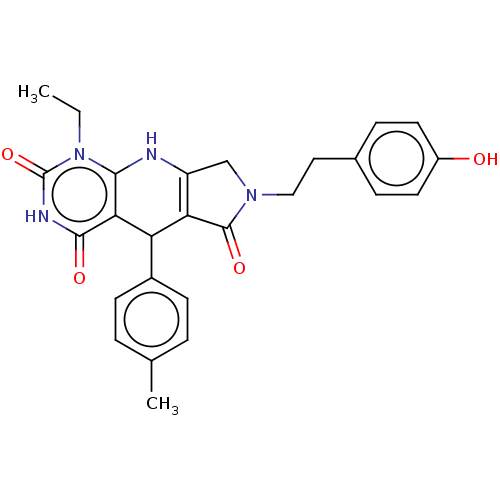BDBM50239567 CHEMBL4085204
SMILES CCn1c2NC3=C(C(c4ccc(C)cc4)c2c(=O)[nH]c1=O)C(=O)N(CCc1ccc(O)cc1)C3
InChI Key InChIKey=VLSYQVCLFAZVNI-UHFFFAOYSA-N
Activity Spreadsheet -- Enzyme Inhibition Constant Data from BindingDB
 Found 4 hits for monomerid = 50239567
Found 4 hits for monomerid = 50239567
TargetBromodomain-containing protein 4(Homo sapiens (Human))
University of Minnesota
Curated by ChEMBL
University of Minnesota
Curated by ChEMBL
Affinity DataKi: 110nMAssay Description:Inhibition of BI-BODIPY binding to BRD4 bromodomain 1 (42 to 168 residues)(unknown origin) expressed in Escherichia coli BL21(DE3) by fluorescence an...More data for this Ligand-Target Pair
TargetBromodomain testis-specific protein(Homo sapiens (Human))
University of Minnesota
Curated by ChEMBL
University of Minnesota
Curated by ChEMBL
Affinity DataKi: 200nMAssay Description:Inhibition of BI-BODIPY binding to BRDT bromodomain 1 (29 to 134 residues) (unknown origin) expressed in Escherichia coli BL21(DE3) by fluorescence a...More data for this Ligand-Target Pair
TargetBromodomain testis-specific protein(Homo sapiens (Human))
University of Minnesota
Curated by ChEMBL
University of Minnesota
Curated by ChEMBL
Affinity DataIC50: 760nMAssay Description:Inhibition of BI-BODIPY binding to BRDT bromodomain 1 (29 to 134 residues) (unknown origin) expressed in Escherichia coli BL21(DE3) by fluorescence a...More data for this Ligand-Target Pair
TargetBromodomain-containing protein 4(Homo sapiens (Human))
University of Minnesota
Curated by ChEMBL
University of Minnesota
Curated by ChEMBL
Affinity DataIC50: 390nMAssay Description:Inhibition of BI-BODIPY binding to BRD4 bromodomain 1 (42 to 168 residues)(unknown origin) expressed in Escherichia coli BL21(DE3) by fluorescence an...More data for this Ligand-Target Pair
